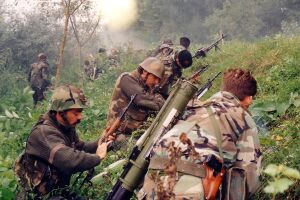Rojtaxis
Rojtaxis (Syaran: Pој такси, roj taksi, literally "Swarm battle order") was the tactical and operational doctrine of the Wardens during the Refusal War, and was employed against the Royalists and their foreign allies.
Rojtaxis was not a deliberate or designed approach to warfare, but a development borne out of necessity and the state of the Warden armies at the onset of the Refusal War. The Armed Forces of the Syaran Republic had dissolved upon the outbreak of fighting and while less than 40% of the officer corps joined the Wardens, nearly 70% of enlisted troops did, highlighting the socioeconomic divide of the Republic of Syara. With much of the NCO corps joining the Wardens, and many of them veterans of the Granika Border War and the Hayren War, the Wardens initially enjoyed a significant level of skill and quality within their tactical formations. However, the lack of large numbers of commissioned officers meant that complex operations both offensive and defensive were difficult for the Wardens to carry out. Because large scale combined arms coordination was difficult, the Wardens opted for largely autonomous units with their own organic combined arms, usually smaller in scale than their Royalist counterparts. The basic operational grouping of the Wardens became the battlegroup, a combined arms force of infantry supported by mortars, and small numbers of armored vehicles. The Wardens went to great lengths to maintain a degree of motorization and mechanized, often seizing civilian automobiles, trucks, motorcycles and bicycles in order to maintain mobility.
Mobility was seen as essential for Warden forces both as a means of offensive and defensive measure. On the attack, Warden armies would conduct multiple assaults from various directions, forcing Royalist troops to defend a large sector even if the Wardens were numerically inferior. Warden forces typically avoided prolonged engagements if possible, wary of remaining static and exposing themselves to Royalist artillery and airpower. Because Warden formations were often outgunned, Warden troops were taught to close with the enemy and engage at close range. This limited the usability of enemy artillery (which risked hitting its own troops if the Wardens got too close), while also exploiting that Warden troops, many of who were devout followers of Zobethos, tended to be more motivated and willing to risk life and limb to accomplish objectives.
The Wardens made extensive use of fieldcraft to negate Royalist advantages, often hiding in ravines, valleys, and between hills to negate the impact of missiles, shells, and rockets. To further offset Royalist advantages, Rojtaxis involved frequent usage of stealth and infiltration, along with deception and decoys to deceive the Royalists and their foreign allies. A typical attack by a Warden brigade involved several sections of Wardens first conducting infiltration efforts into a Royalist position, followed by a rapid push to contact and close quarters combat. Because they initially faced difficulty coordinating large formations, the Wardens tended to go "all in"; a brigade assault would involve nearly all its battlegroups, with only a limited reserve. A decision to withdraw was usually made by the battlegroup commander rather than at the brigade or division level. Likewise, the decision to press an assault was usually a tactical rather than a operational one.
To counter enemy air power the Wardens employed a number of tactics. One method involved rigging up old radar systems near a live mobile air defense system; the older radars would attract anti-radiation missiles away from the air defense system, which would fire after the enemy aircraft had already attempted to engage. Other methods involved deception and decoys; in one instance the Wardens successfully hid an entire bridge from the Royalists and their allies by building a highly visible mock up less than 100 meters upstream, then covering the real bridge with darkened tarps to make it appear to blend into the river, thus leading aerial and satellite reconnaissance to assume the mock up was the real target. Warden troops would often capture and repaint damaged armored vehicles they were not capable of repairing, then positioning them to serve as bait for enemy aircraft, while air defense teams waited nearby.
Because their actions often involved rapid attacks by largely infantry formations, it was common for observers during the war to label Warden tactics as "human wave attacks", but historians label this inaccurate. Warden assaults on fortified positions were often highly aggressive with limited reserves and conducted on strict time tables in order to maximize surprise, thus giving the impression of a large scale human mass converging on a defensive position at once, but this required significant coordination and tactical flexibility on the part of the Wardens. As the war waged on, Warden forces gradually grew more capable of carrying out complex combined arms operations, launching ground assaults supported by artillery and air power.
Rojtaxis and the Wardens are not typically identified as forming a type of guerrilla warfare owing to their emphasis on mechanization and frequency of set piece battles. Nevertheless, the Wardens took major inspiration from famous guerrilla armies and other asymmetric forces throughout the history of Tyran, and many of their tactics were seen as replications of guerrilla efforts. The Wardens were inspired by the methods of the People's Army and Lidia's Legion of the Gylian Liberation War, along with the methods of Operation Quoc To by Quenmin during the Siduri War. As a result, many Wardens referred to their fighting style as Istočnata Taktika; "Eastern Tactics".
